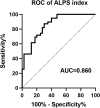Diffusion Tensor Imaging Analysis Along the Perivascular Space (DTI-ALPS) Demonstrates That Sleep Disorders Exacerbate Glymphatic Circulatory Impairment and Cognitive Impairment in Patients with Alzheimer's Disease
- PMID: 39735385
- PMCID: PMC11675307
- DOI: 10.2147/NSS.S496607
Diffusion Tensor Imaging Analysis Along the Perivascular Space (DTI-ALPS) Demonstrates That Sleep Disorders Exacerbate Glymphatic Circulatory Impairment and Cognitive Impairment in Patients with Alzheimer's Disease
Abstract
Objective: Sleep disorders are common in Alzheimer's disease (AD) patients and can impair the glymphatic system, leading to cognitive decline. This study aimed to investigate whether AD patients with sleep disorders exhibit worse glymphatic function and more severe cognitive impairment compared to those without sleep disorders and to explore the underlying molecular imaging mechanisms.
Methods: This study included 40 AD patients with sleep disorders (ADSD), 39 cognitively matched AD patients without sleep disorders (ADNSD), and 25 healthy middle-aged and elderly controls (NC). Participants underwent functional magnetic resonance imaging (fMRI), and cognitive and sleep assessments. The ALPS (Along the Perivascular Space) index was calculated, followed by intergroup comparisons, correlation analyses, and mediation analyses. The diagnostic utility of the ALPS index was assessed using a receiver operating characteristic (ROC) curve.
Results: The ALPS index was lower in the ADNSD and ADSD groups compared to the NC group. In the ADSD group, PSQI scores were negatively correlated with MMSE scores. The ALPS index was positively correlated with MMSE scores and negatively with PSQI scores. Mediation analyses indicated that the ALPS index partially mediated the effect of sleep disturbances on cognitive impairment (indirect effect = -0.134; mediation effect = 30.505%). The area under the ROC curve (AUROC) for distinguishing ADSD from ADNSD was 0.86, with a cutoff ALPS index value 1.309.
Conclusion: Sleep disorders worsen glymphatic function and cognitive impairment in AD patients. The ALPS index partially mediates the impact of sleep disorders on cognitive function and shows moderate accuracy in distinguishing between patients with ADSD and ADNSD.
Keywords: Alzheimer’s disease; diffusion tensor imaging analysis along the perivascular space (DTI-ALPS); glymphatic system; mediation analysis; sleep disorders.
© 2024 Shang et al.
Conflict of interest statement
The authors report no conflicts of interest in this work.
Figures






Similar articles
-
Glymphatic system impairment in Alzheimer's disease: associations with perivascular space volume and cognitive function.Eur Radiol. 2024 Feb;34(2):1314-1323. doi: 10.1007/s00330-023-10122-3. Epub 2023 Aug 23. Eur Radiol. 2024. PMID: 37610441
-
Resting-state fMRI network efficiency as a mediator in the relationship between the glymphatic system and cognitive function in obstructive sleep apnea hypopnea syndrome: Insights from a DTI-ALPS investigation.Sleep Med. 2024 Jul;119:250-257. doi: 10.1016/j.sleep.2024.05.009. Epub 2024 May 3. Sleep Med. 2024. PMID: 38704873
-
Perivascular space and white matter hyperintensities in Alzheimer's disease: associations with disease progression and cognitive function.Alzheimers Res Ther. 2025 Mar 18;17(1):62. doi: 10.1186/s13195-025-01707-9. Alzheimers Res Ther. 2025. PMID: 40098158 Free PMC article.
-
Glymphatic pathway dysfunction in severe obstructive sleep apnea: A meta-analysis.Sleep Med. 2025 Jul;131:106528. doi: 10.1016/j.sleep.2025.106528. Epub 2025 Apr 21. Sleep Med. 2025. PMID: 40267528
-
Exploring Potential Mechanisms of Sleep Disorders in Alzheimer's Dementia: A Scoping Review.Cureus. 2025 Jan 3;17(1):e76859. doi: 10.7759/cureus.76859. eCollection 2025 Jan. Cureus. 2025. PMID: 39902010 Free PMC article. Review.
References
-
- Chappel-Farley MG, Lui KK, Dave A, Chen IY, Mander BA. Candidate mechanisms linking insomnia disorder to Alzheimer’s disease risk. Curr Opin Behav Sci. 2020;33:92–98. doi:10.1016/j.cobeha.2020.01.010 - DOI
LinkOut - more resources
Full Text Sources

